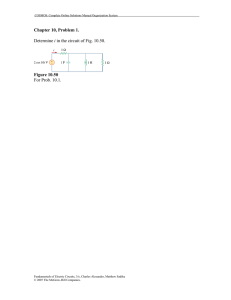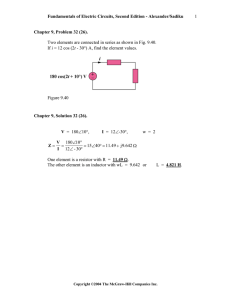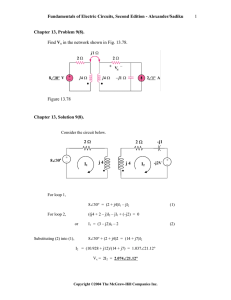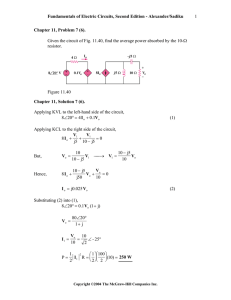08.100 V2.241 = −
advertisement
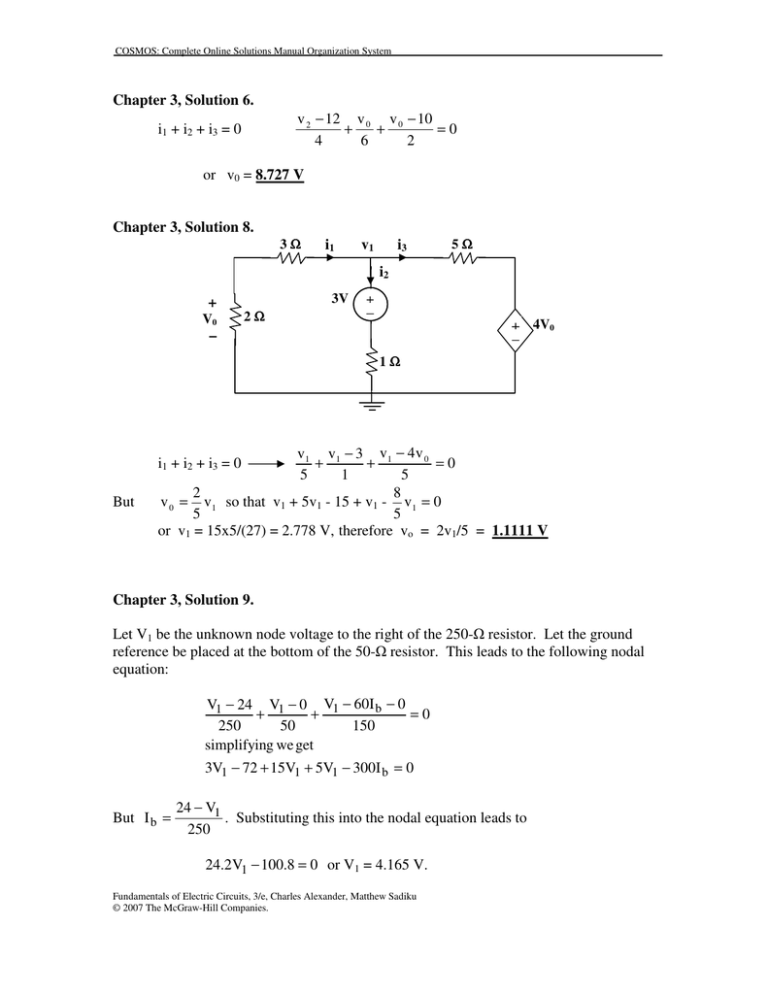
COSMOS: Complete Online Solutions Manual Organization System Chapter 3, Solution 6. v 2 − 12 v 0 v 0 − 10 + + =0 4 6 2 i1 + i2 + i3 = 0 or v0 = 8.727 V Chapter 3, Solution 8. 3Ω i1 v1 i3 5Ω i2 3V + V0 2Ω + – + 4V0 – – 1Ω v1 v1 − 3 v1 − 4 v 0 + + =0 5 1 5 2 8 v 0 = v1 so that v1 + 5v1 - 15 + v1 - v1 = 0 5 5 or v1 = 15x5/(27) = 2.778 V, therefore vo = 2v1/5 = 1.1111 V i1 + i2 + i3 = 0 But Chapter 3, Solution 9. Let V1 be the unknown node voltage to the right of the 250-Ω resistor. Let the ground reference be placed at the bottom of the 50-Ω resistor. This leads to the following nodal equation: V1 − 24 V1 − 0 V1 − 60I b − 0 + + =0 250 50 150 simplifying we get 3V1 − 72 + 15V1 + 5V1 − 300I b = 0 But I b = 24 − V1 . Substituting this into the nodal equation leads to 250 24.2V1 − 100.8 = 0 or V1 = 4.165 V. Fundamentals of Electric Circuits, 3/e, Charles Alexander, Matthew Sadiku © 2007 The McGraw-Hill Companies. COSMOS: Complete Online Solutions Manual Organization System Thus, Ib = (24 – 4.165)/250 = 79.34 mA. Chapter 3, Solution 13. At node number 2, [(v2 + 2) – 0]/10 + v2/4 = 3 or v2 = 8 volts But, I = [(v2 + 2) – 0]/10 = (8 + 2)/10 = 1 amp and v1 = 8x1 = 8volts Chapter 3, Solution 20. Nodes 1 and 2 form a supernode; so do nodes 1 and 3. Hence V1 V2 V3 + + =0 → V1 + 4V2 + V3 = 0 (1) 4 1 4 . V1 . 4Ω V2 2Ω 1Ω Between nodes 1 and 3, − V1 + 12 + V3 = 0 → V3 = V1 − 12 Similarly, between nodes 1 and 2, V1 = V2 + 2i But i = V3 / 4 . Combining this with (2) and (3) gives . V2 V3 = 6 + V1 / 2 Solving (1), (2), and (4) leads to V1 = −3V, V2 = 4.5V, V3 = −15V Fundamentals of Electric Circuits, 3/e, Charles Alexander, Matthew Sadiku © 2007 The McGraw-Hill Companies. 4Ω (2) (3) (4) COSMOS: Complete Online Solutions Manual Organization System Chapter 3, Solution 23. We apply nodal analysis to the circuit shown below. 1Ω 30 V 2 Vo 4Ω Vo + V1 – + + _ 2Ω Vo 16 Ω _ 3A At node o, Vo − 30 Vo − 0 Vo − (2Vo + V1 ) + + = 0 → 1.25Vo − 0.25V1 = 30 1 2 4 (1) At node 1, (2Vo + V1 ) − Vo V1 − 0 + − 3 = 0 → 5V1 + 4Vo = 48 4 16 (2) From (1), V1 = 5Vo – 120. Substituting this into (2) yields 29Vo = 648 or Vo = 22.34 V. Chapter 3, Solution 34. (a) This is a planar circuit because it can be redrawn as shown below, 7Ω 2Ω 1Ω 3Ω 6Ω 10 V + – Fundamentals of Electric Circuits, 3/e, Charles Alexander, Matthew Sadiku 4Ω © 2007 The McGraw-Hill Companies. 5Ω COSMOS: Complete Online Solutions Manual Organization System (b) This is a non-planar circuit. Chapter 3, Solution 36. 10 V 4Ω +– i1 12 V + i2 I1 – i3 I2 2Ω 6Ω Applying mesh analysis gives, 12 = 10I1 – 6I2 -10 = -6I1 + 8I2 Fundamentals of Electric Circuits, 3/e, Charles Alexander, Matthew Sadiku © 2007 The McGraw-Hill Companies. COSMOS: Complete Online Solutions Manual Organization System 6 5 − 3 I 1 − 5 = − 3 4 I 2 or ∆= −3 6 −3 5 6 = 11, ∆1 = = 9, ∆ 2 = = −7 −3 4 −5 4 −3 −5 5 I1 = ∆1 9 I = ∆2 = − 7 = , 2 ∆ 11 ∆ 11 i1 = -I1 = -9/11 = -0.8181 A, i2 = I1 – I2 = 10/11 = 1.4545 A. vo = 6i2 = 6x1.4545 = 8.727 V. Chapter 3, Solution 38. Consider the circuit below with the mesh currents. 4Ω + _ 24 V 3Ω I3 I4 1Ω 4A 2Ω 2Ω Io 1Ω 1Ω I1 I2 4Ω 2A Fundamentals of Electric Circuits, 3/e, Charles Alexander, Matthew Sadiku © 2007 The McGraw-Hill Companies. + _ 9V COSMOS: Complete Online Solutions Manual Organization System I1 =-2 A (1) 1(I2–I1) + 2(I2–I4) + 9 + 4I2 = 0 7I2 – I4 = –11 (2) –24 + 4I3 + 3I4 + 1I4 + 2(I4–I2) + 2(I3 – I1) = 0 (super mesh) –2I2 + 6 I3 + 6I4 = +24 – 4 = 20 (3) But, we need one more equation, so we use the constraint equation –I3 + I4 = 4. This now gives us three equations with three unknowns. 0 − 1 I 2 − 11 7 − 2 6 6 I = 20 3 0 − 1 1 I 4 4 We can now use MATLAB to solve the problem. >> Z=[7,0,-1;-2,6,6;0,-1,0] Z= 7 0 -1 -2 6 6 0 -1 0 >> V=[-11,20,4]' V= -11 20 4 >> I=inv(Z)*V I= -0.5500 -4.0000 7.1500 Io = I1 – I2 = –2 – 4 = –6 A. Chapter 3, Solution 86. Let v1 be the potential across the 2 k-ohm resistor with plus being on top. Then, Fundamentals of Electric Circuits, 3/e, Charles Alexander, Matthew Sadiku © 2007 The McGraw-Hill Companies. COSMOS: Complete Online Solutions Manual Organization System [(0.03 – v1)/1k] + 400i = v1/2k (1) Assume that i is in mA. But, i = (0.03 – v1)/1 (2) Combining (1) and (2) yields, v1 = 29.963 mVolts and i = 37.4 nA, therefore, v0 = -5000x400x37.4x10-9 = -74.8 mvolts Chapter 4, Solution 1. 1Ω 1V 8 (5 + 3) = 4Ω , i = io = 5Ω i + − io 8Ω 3Ω 1 1 = 1+ 4 5 1 1 i= = 0.1A 2 10 Since the resistance remains the same we get i = 10/5 = 2A which leads to io = (1/2)i = (1/2)2 = 1A. Chapter 4, Solution 3. R 3R io Vs + − 3R 3R + 1V R + − 3R vo Fundamentals of Electric Circuits, 3/e, Charles Alexander, Matthew Sadiku © 2007 The McGraw-Hill Companies. (a) (b) 1.5R COSMOS: Complete Online Solutions Manual Organization System (a) We transform the Y sub-circuit to the equivalent ∆ . 3R 2 3 3 3 3 R 3R = = R, R + R = R 4R 4 4 4 2 v v o = s independent of R 2 io = vo/(R) When vs = 1V, vo = 0.5V, io = 0.5A (b) (c) When vs = 10V, vo = 5V, io = 5A When vs = 10V and R = 10Ω, vo = 5V, io = 10/(10) = 500mA Fundamentals of Electric Circuits, 3/e, Charles Alexander, Matthew Sadiku © 2007 The McGraw-Hill Companies.
